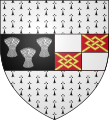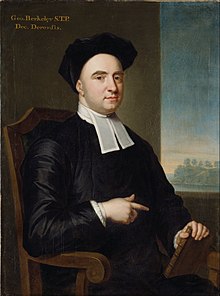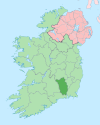Portal:County Kilkenny
The County Kilkenny Portal
County Kilkenny (Irish: Contae Chill Chainnigh) is a county in Ireland. It is in the province of Leinster and is part of the Southern Region. It is named after the city of Kilkenny. Kilkenny County Council is the local authority for the county. At the 2022 census the population of the county was 103,685. The county was based on the historic Gaelic kingdom of Ossory (Osraighe), which was coterminous with the Diocese of Ossory. (Full article...)
Selected articles

County Kilkenny (Irish: Contae Chill Chainnigh) is a county in Ireland. It is in the province of Leinster and is part of the Southern Region. It is named after the city of Kilkenny. Kilkenny County Council is the local authority for the county. At the 2022 census the population of the county was 103,685. The county was based on the historic Gaelic kingdom of Ossory (Osraighe), which was coterminous with the Diocese of Ossory. (Full article...)
Selected history articles

Osraige (Old Irish) or Osraighe (Classical Irish), Osraí (Modern Irish), anglicized as Ossory, was a medieval Irish kingdom comprising what is now County Kilkenny and western County Laois, corresponding to the Diocese of Ossory. The home of the Osraige people, it existed from around the first century until the Norman invasion of Ireland in the 12th century. It was ruled by the Dál Birn dynasty, whose medieval descendants assumed the surname Mac Giolla Phádraig.
According to tradition, Osraige was founded by Óengus Osrithe in the 1st century and was originally within the province of Leinster. In the 5th century, the Corcu Loígde of Munster displaced the Dál Birn and brought Osraige under Munster's direct control. The Dál Birn returned to power in the 7th century, though Osraige remained nominally part of Munster until 859, when it achieved formal independence under the powerful king Cerball mac Dúnlainge. Osraige's rulers remained major players in Irish politics for the next three centuries, though they never vied for the High Kingship. In the early 12th century, dynastic infighting fragmented the kingdom, and it was re-adjoined to Leinster. The Normans under Strongbow invaded Ireland beginning in 1169, and most of Osraige collapsed under pressure from Norman leader William Marshal. The northern part of the kingdom, eventually known as Upper Ossory, survived intact under the hereditary lordship until the reign of King Henry VIII of England, when it was formally incorporated as a barony of the same name. (Full article...)
Selected landmarks articles

Kilkenny Castle (Irish: Caisleán Chill Chainnigh pronounced [ˈkaʃlʲaːnˠˈçiːl̪ʲˈxan̪ʲiː]) is a castle in Kilkenny, Ireland, built in 1260 to control a fording-point of the River Nore and the junction of several routeways. It was a symbol of Norman occupation, and in its original 13th-century condition, it would have formed an important element of the town's defences with four large circular corner towers and a massive ditch, part of which can still be seen today on the Parade.
In 1967, Arthur Butler, 6th Marquess of Ormonde, sold the castle for £50 to the Castle Restoration Committee for the people of Kilkenny. The castle and grounds are now managed by the Office of Public Works, and the gardens and parkland are open to the public. The Parade Tower is a conference venue. Since 2002, ceremonies for conferring awards and degrees on the graduates of the Kilkenny Campus of the National University of Ireland, Maynooth, have been held at the castle. (Full article...)
Selected geography articles
Galmoy (Irish: Gabhalmhaigh, meaning "plain of the Ghabhal [River Goul]") is a barony in the north western part of County Kilkenny, Ireland. It is one of 12 baronies in County Kilkenny. The size of the barony is 162.7 square kilometres (62.8 sq mi). There are 12 civil parishes in Galmoy. While it is named after the village of Galmoy, today the chief town of the barony is Urlingford. Galmoy barony lies at the north-western corner of the county between Fassadinin to the east (whose chief town is Castlecomer), and Crannagh to the south (whose chief town is Freshford). It is surrounded on two sides by counties Tipperary to the west and Laois to the north. The M8 Dublin/Cork motorway bisects the barony. It is situated 121 kilometres (75 mi) from Dublin city and 131 kilometres (81 mi) from Cork city. Galmoy is currently administered by Kilkenny County Council. The barony was part of in the historic kingdom of Osraige (Ossory). (Full article...)
| Year | Pop. | ±% |
|---|---|---|
| 1821 | 1,812 | — |
| 1831 | 2,175 | +20.0% |
| 1841 | 2,075 | −4.6% |
| 1851 | 1,076 | −48.1% |
| 1861 | 953 | −11.4% |
| 1871 | 915 | −4.0% |
| 1881 | 733 | −19.9% |
| 1891 | 622 | −15.1% |
| 1901 | 551 | −11.4% |
| 1911 | 446 | −19.1% |
| 1926 | 413 | −7.4% |
| 1936 | 456 | +10.4% |
| 1946 | 474 | +3.9% |
| 1951 | 491 | +3.6% |
| 1956 | 626 | +27.5% |
| 1961 | 656 | +4.8% |
| 1966 | 565 | −13.9% |
| 1971 | 585 | +3.5% |
| 1981 | 747 | +27.7% |
| 1986 | 700 | −6.3% |
| 1991 | 651 | −7.0% |
| 1996 | 632 | −2.9% |
| 2002 | 756 | +19.6% |
| 2006 | 734 | −2.9% |
| 2011 | 685 | −6.7% |
| 2016 | 662 | −3.4% |
Freshford (Irish: Achadh Úr, meaning "fresh field") is a village and former town in the barony of Crannagh, County Kilkenny, Ireland. It is 13 km north-west of Kilkenny city. The village is in a civil parish of the same name. (Full article...)
The River Suir (/ʃʊər/ SHOOR; Irish: an tSiúr [ənʲ ˈtʲuːɾˠ] or Abhainn na Siúire [ˌəun̠ʲ n̪ˠə ˈʃuːɾʲə]) is a river in Ireland that flows into the Atlantic Ocean through Waterford after a distance of 185 kilometres (115 mi). The catchment area of the Suir is 3,610 km2. Its long term average flow rate is 76.9 cubic metres per second (m3/s), about twice the flow of either the River Barrow (37.4 m3/s) or the River Nore (42.9 m3/s) before these join, but a little less than the Barrow's flow when it meets the Suir 20 km downstream (over 80 m3/s). (Full article...)
The Barrow Way (Irish: Slí na Bearú) is a long-distance trail in Ireland. It is 100 kilometres (62 miles) long and begins in Robertstown, County Kildare and ends in St Mullin's, County Carlow, following the course of the River Barrow and the Barrow Line of the Grand Canal through counties Kildare, Carlow, Kilkenny and Laois. It is typically completed in four days. It is designated as a National Waymarked Trail by the National Trails Office of the Irish Sports Council and is managed by Waterways Ireland. (Full article...)
Selected quotation
"If you ever go to Kilkenny, Remember the Hole in the Wall, You may there get drunk for a penny, Or tipsy for nothing at all."
|
— Unknown, circa 18th Century. |
Selected Did you know

- ...that under Brian Cody's (pictured) management the Kilkenny GAA team won five league-championship doubles?
- ...that the Butler dynasty refers to the several branches of the Butler family, which included the Butlers of Ormond, who's family seat, since 1391, was Kilkenny Castle. (Full article...)
Selected slideshow image
Selected biography articles
George Berkeley (/ˈbɑːrkli/ BARK-lee; 12 March 1685 – 14 January 1753) – known as Bishop Berkeley (Bishop of Cloyne of the Anglican Church of Ireland) – was an Anglo-Irish philosopher whose primary achievement was the advancement of a theory he called "immaterialism" (later referred to as "subjective idealism" by others). This theory denies the existence of material substance and instead contends that familiar objects like tables and chairs are ideas perceived by the mind and, as a result, cannot exist without being perceived. Berkeley is also known for his critique of abstraction, an important premise in his argument for immaterialism.
In 1709, Berkeley published his first major work, An Essay Towards a New Theory of Vision, in which he discussed the limitations of human vision and advanced the theory that the proper objects of sight are not material objects, but light and colour. This foreshadowed his chief philosophical work, A Treatise Concerning the Principles of Human Knowledge, in 1710, which, after its poor reception, he rewrote in dialogue form and published under the title Three Dialogues Between Hylas and Philonous in 1713. In this book, Berkeley's views were represented by Philonous (Greek: "lover of mind"), while Hylas ("hyle", Greek: "matter") embodies the Irish thinker's opponents, in particular John Locke. (Full article...)
John O'Donovan (Irish: Seán Ó Donnabháin; 25 July 1806 – 10 December 1861), from Atateemore, in the parish of Kilcolumb, County Kilkenny, and educated at Hunt's Academy, Waterford, was an Irish language scholar from Ireland. (Full article...)
Letitia Bushe (c.1705/1710 – 17 November 1757) was an Irish watercolourist and miniaturist. (Full article...)
John Locke (1847–1889) was an Irish writer and Fenian activist, exiled to the United States, and most famous for writing "Dawn on the Irish Coast", also known as "The Exiles Return, or Morning on the Irish coast". (Full article...)
Selected sport articles
Liz Neary (born 1951 in Kilkenny, Ireland) is a retired Irish sportsperson. She played camogie at various times with her local clubs St. Paul's and Austin Stacks and was a member of the Kilkenny senior inter-county team from 1970 until 1987. Neary is regarded as one of the greatest players of all-time.
In a senior inter-county career that lasted for nineteen years she won seven All-Ireland medals, five National League medals and five Gael Linn Interprovincial medals. With her two clubs St. Paul's and Austin Stack's she collected a huge haul of twenty-one county titles and six All-Ireland club medals. (Full article...)
Related portals
Associated Wikimedia
The following Wikimedia Foundation sister projects provide more on this subject:
-
Commons
Free media repository -
Wikibooks
Free textbooks and manuals -
Wikidata
Free knowledge base -
Wikinews
Free-content news -
Wikiquote
Collection of quotations -
Wikisource
Free-content library -
Wikiversity
Free learning tools -
Wikivoyage
Free travel guide -
Wiktionary
Dictionary and thesaurus
































































